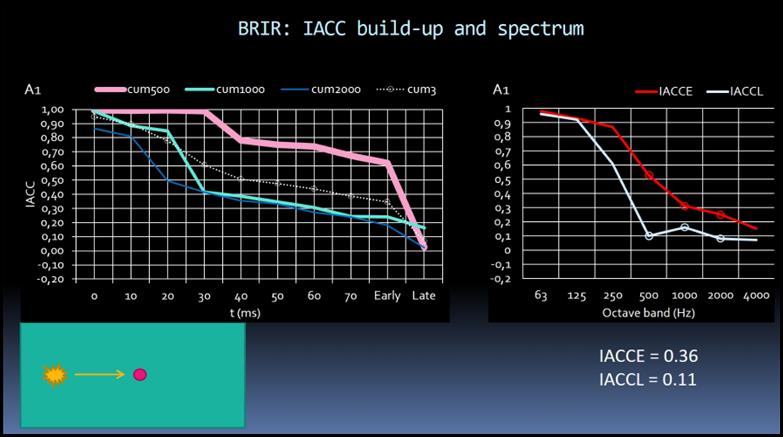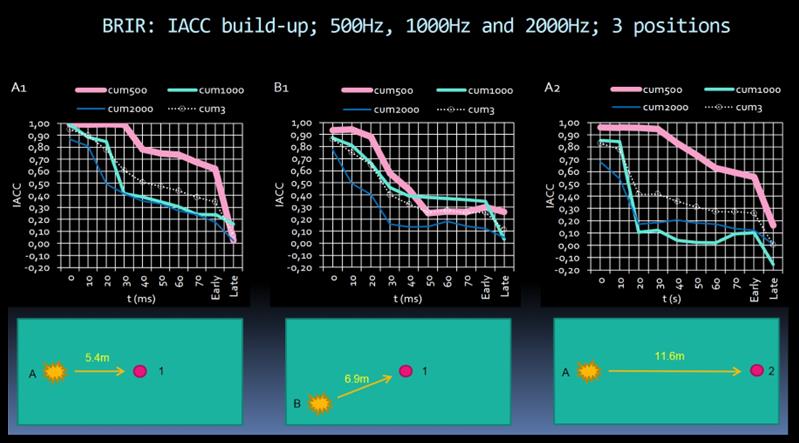
|
BRIR buildup |
|
How does Lateral energy and Median Energy build up in a Binaural Room Impulse Response (BRIR) ? Inter-aural cross-correlation of early sound in a binaural impulse response (BRIR) is abbreviated IACCE. According to common practice, as well as the standard ISO-3382, ‘early’ means the part of BRIR from 0 ms to 80 ms. From Definitions , we can interprete IACCE as the Median-to-Lateral energy balance of early BRIR, and Binaural Lateral Fraction can be calculated from BLF = 0.5·(1-IACCE). Note that BLF differs from LF since the latter is measured by a omni– and figure-8 microphone combination or by two closely spaced omni-microphones, while BLF is measured with one omni-microphone at each ear of a dummy or a real pearson. While information about the Midian-to-Lateral energy balance in the first 80ms of BRIR can be obtained from IACCE, we cannot tell from IACCE how this balance cumulates during these first 80ms. E.g., we do not know whether the IACCE has been establisehed soon after direct sound arrival, or right before the 80ms limit. We suspect that the two extreme cases would cause an audible difference. In the first case, the brain would have little time to detect azimuth direction and to establish localization. IACCL is taken from the late part, i.e. after 80ms in the BRIR. In Figure 1 (right), we see the spectra of IACCE and IACCL from a 10m wide, 25m long room, 1400m3 volume and mid-frequency RT=0.88 with quite flat spectrum. The room, originally a barn with pitched roof of exposed wood structure and covering, on 2.2m high walls, at the time of measurements covered with wood fibre insulation behind a sheet of moisture-permeable fabric, essentially a broad band absorber but more reflective toward the highest frequencies. To the left we see how IACC builds up during the first 80ms of an binaural impulse response, in the mid-frequency octaves 500Hz, 1000Hz, 2000Hz and the average of the 3 octaves, “cum3”. Comment: In the diagram to the left, the dotted “cum3” curve slopes gradually downward from 1.0 during the 0-70ms, towards the “Early” value (IACCE) at 80ms. However, the octave band curves reveal that lower octaves maintain a high value longer than the higher ones do, indicating that lateral sound build up quicker at higher frequencies. In particular, at 500Hz there is a dramatic increase in lateral fraction from the early part to the late part, which means that low frequency lateral sound builds up slowly in this room. Figure 1, (left) Cumulative build-up of IACC during the first 80ms of a BRIR, in 500Hz, 1000Hz, 2000Hz octaves and their average “cum3”, in a 10m wide room with 1500m3 volume and mid-frequency RT=0.88ms; Right: spectra of IACCE and IACCL. The example in Figure 1 has IACCE = 0.36, which in a big concert hall would be according to recommended value in order to achieve apparent source width ASW or source broadening. However, in a small room like this, being 10ms wide, the lateral reflections that determines IACCE arrive very early, introduceing the aforementioned doubt about conditions for localization. It would be interesting to see if other positions in the same room have similar or different build-up pattern. There are two impulse source positions, A and B, and two binaural receiver positions, 1 and 2, to yield source-receiver combinations A1, B1 and A2. In Figure 2 we see cumulative lateral energy and cumulative median energy in the first 80 ms of BRIRs from A1, A2 and A2. In all of them, lateral fraction has cumulated strongly at 20-30ms of the BRIR. In A2, where the source-receiver distance (11.6m) exceeds the width of the room (10m), the IACCE values at 1kHz and 2kHz are achieved already at 20ms after arrival of direct sound. As a conclusion, we see that although details vary through A1-B1-A2, the window in which localization can be established in this room is very short, i.e. 20-30ms long. This was due to the (narrow) width of the room. For this reason, walls were made sound absorbing, in order to counteract the sound impression of a narrow room. Alone, this measure would cause RT to be shorter than preferred, but this was solved by installing an active acoustics system (AAS), also known as acoustic enhancement system (AES). As a result, a virtually bigger room had been created. Further we conclude from these observations that the dynamic behaviour of IACC can differ very much between different octave bands, even if the RT spectrum is flat. Figure 2, Buildup of IACC in three surce-receiver combinations.
...to be continued…. |
|
Page created 06.04.2017 Latest change 21.08.2019 |
|
Binaural Project sub-pages |
Binaural Project links |
|
Measurements of IACC during music performance in concert halls 01.02.2017 |
|
|
ISMRA presentation 11.09.2016, ASA-Boston-2017-presentation 29.06.2017 |
|
|
|

